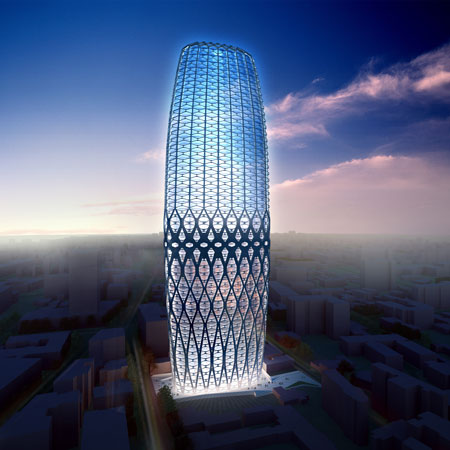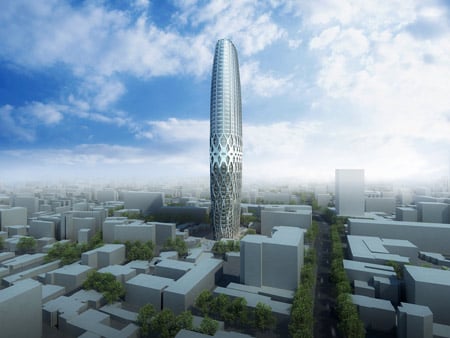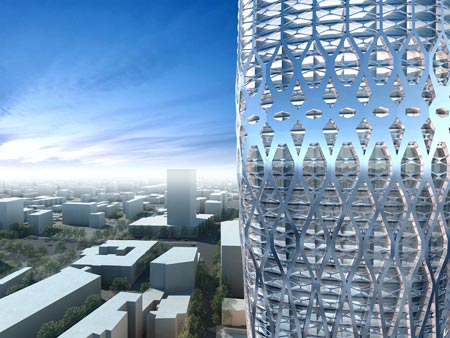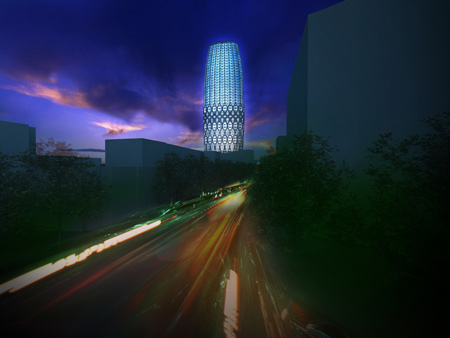
Dorobanti Tower by Zaha Hadid Architects
Zaha Hadid Architects have designed a high-rise building for the center of Bucharest, Romania, which has a structural, lattice façade.

It will contain a five star hotel, a business centre, a casino, retail areas, apartments and underground parking.

Construction is expected to be completed in 2013.

See all our stories about Zaha Hadid Architects in our special category.

Here's some text from Zaha Hadid Architects:
--
Architectural Concept:
The brief called for a 100,000 square metre mixed-use, high-rise development in the centre of Bucharest. The project comprises of a 5-star hotel, luxury apartments, retail areas, a business centre, a casino and underground parking.
The Dorobanti Tower was designed to establish an iconic presence in the heart of Bucharest. The new tower is a unique mix of a distinctive form, ingenious structure, and spatial qualities of sky-high living. The purity of its form - a chamfered diamond like structure - will be a new landmark in the centre of Bucharest. Zaha Hadid Architect’s design concept is a synthesis of architecture and engineering, which integrates a distinct meandering structural lattice.
Urban parameters, site constraints and the programme generate the building’s elegant tapering profile. The new tower establishes a distinctive identity while avoiding sterile repetition through its dynamically changing profile. In order to maximise lighting and views for the neighbourhoods, the elongated curvilinear shape reduces its perimeter towards the top, while the offset to the inside at ground floor level shall create a generous public realm and an appropriate entrance plaza in front of the tower.
Facade / Structure:
Bucharest is within a vulnerable seismic zone and therefore the structural concept was crucial to us from the beginning of the design process. Placing the primary structure at the exterior not only maximises the structural footprint but also allows for column free interior spaces.
Concrete filled stainless steel profiles follow in sinus waves from the ground level to the top of the tower, creating a distinctive identity, complementing the tower design. The concrete filling will give additional strength to the structure and it will provide fire protection to the steel profiles. The facade structure expresses the various programmes and it adjusts from bottom to top according to the changing structural forces. The secondary structure, which is integrated between the main steel tubes, gives additional strength to the primary steel mesh and it also works as a damper in case of earthquakes.
At the bottom, the façade grid has denser amplitudes according to the structural requirements for a tower of this height, providing the required load bearing capacity and stiffness to the structure. At the technical and recreational levels, the structure condenses creating almost solid knots. On the top floors, the primary structure has been reduced to the minimum according to the structural requirements in order to maximise the views and lighting for the luxury apartments.
Landscape:
The public realm adjacent to the tower will be unlike anything else in Bucharest, representing a major attraction within the dense urban character of the City, offering an important new meeting space and urban plaza. Metaphorically speaking, the landscaping can be understood as a warped concrete “carpet” with one continuous surface connecting the three surrounding streets. The landscape is sculpted to create seating areas, water basins, fountains, green areas including trees and a raised terrace.
Program: 5 Star Hotel and Apartments
Client: Smartown Group
Design: Zaha Hadid with Patrik Schumacher
Project Architect: Markus Planteu
Project Team: Dennis Brezina, Naomi Fritz, Susanne Lettau, Thomas Mathoy, Goswin Rothenthal, Rooshad Shroff, Seda Zirek